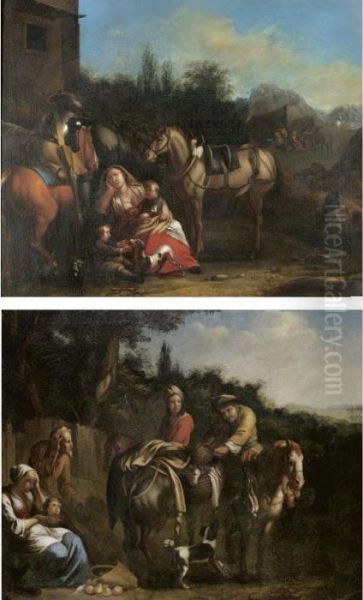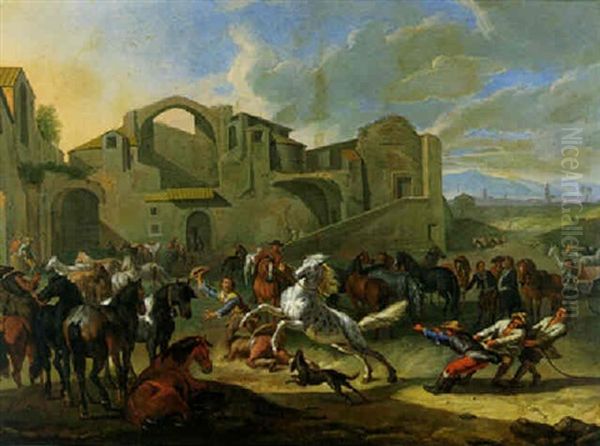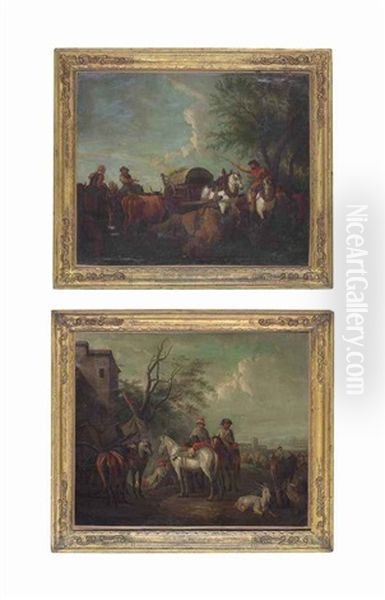An Introduction to 'Standaart'
Pieter van Bloemen, a distinguished Flemish painter of the Baroque era, carved a significant niche for himself in the annals of art history primarily through his masterful depictions of animals, particularly horses, lively market scenes, and detailed military encampments. Born in Antwerp on January 17, 1657, and passing away in the same city on March 6, 1720, his life and career spanned a dynamic period of artistic exchange between Northern Europe and Italy. His exceptional skill in rendering horses and his frequent inclusion of standards and banners in his military compositions earned him the evocative nickname "Standaart" (Standard or Banner) among his peers, a moniker that underscored his thematic specialization and technical prowess. While perhaps sometimes overshadowed by the landscape fame of his younger brother, Jan Frans van Bloemen, Pieter remains a crucial figure for understanding Flemish painting in the late 17th and early 18th centuries, especially its engagement with Italianate styles.
Early Life and Artistic Formation in Antwerp
Pieter van Bloemen's journey into the world of art began in Antwerp, a city that, despite facing economic challenges, still retained a vibrant artistic legacy inherited from masters like Peter Paul Rubens and Anthony van Dyck. Growing up in an artistic family undoubtedly shaped his path; both his younger brothers, Jan Frans and Norbert van Bloemen, would also become painters. This familial environment likely provided early exposure and encouragement.
His formal training commenced under Simon Johannes van Douw, a painter known for his battle scenes and landscapes with horses. This apprenticeship was pivotal, grounding the young Pieter in the genres that would define much of his career. Van Douw's influence is discernible in Van Bloemen's early attention to equine anatomy and dynamic compositions involving cavalry or military subjects. The artistic milieu of Antwerp, with its established Guild of Saint Luke, provided a structured path for aspiring artists.

Demonstrating remarkable precocity, Pieter van Bloemen was registered as a master in the Antwerp Guild of Saint Luke in the guild year 1673-1674, when he was only seventeen years old. This early recognition speaks volumes about his talent and the quality of his work even at a young age. Membership in the guild was essential for practicing professionally, selling works, and taking on pupils, marking the official start of his independent career in his native city. His early works from this period likely focused on themes popular in the Flemish market, including genre scenes and animal paintings, already showcasing his affinity for horses.
The Italian Sojourn: Rome and the Schildersbent
Like many Northern European artists of his time, Pieter van Bloemen felt the magnetic pull of Italy, the cradle of classical antiquity and the Renaissance. Around 1684, he embarked on a journey southward, initially traveling to Lyon, possibly accompanied by fellow artists. His ultimate destination was Rome, which he reached likely by 1685. He was joined there by his brother, Jan Frans, and later by their younger brother, Norbert. Rome, at this time, was a bustling international hub for artists, offering unparalleled opportunities to study ancient ruins, Renaissance and Baroque masterpieces, and the vibrant contemporary art scene.
In Rome, Pieter became an active member of the Schildersbent, more famously known as the Bentvueghels ('Birds of a Feather'). This confraternity of mostly Dutch and Flemish artists living in Rome was known for its bohemian lifestyle, initiation rituals, and mutual support system. It was within this circle that Pieter received his 'bent' nickname, "Standaart." This practice of bestowing often humorous or descriptive nicknames was a hallmark of the Bentvueghels. His moniker directly referenced his penchant for painting military subjects featuring prominent standards and flags, a testament to how quickly his specialization became recognized even in the competitive Roman environment.
His time in Rome, lasting roughly until 1694, was profoundly influential. He immersed himself in the Italianate style, absorbing the warm light, picturesque landscapes dotted with ancient ruins, and the classical compositions favored by artists working in the city. He associated with other Northern artists who had adapted their styles, such as Gaspar van Wittel (Vanvitelli), known for his detailed cityscapes (vedute), and likely encountered the works of earlier Italianate painters like Karel Dujardin and Johannes Lingelbach, whose depictions of Italian peasant life and landscapes were highly popular. This period solidified his style, blending his Flemish precision with Italian atmosphere.
Artistic Style: Animals, Armies, and Atmosphere
Pieter van Bloemen's artistic identity is inextricably linked to his specialization in certain themes, executed with a distinctive blend of Flemish detail and Italianate sensibility. His reputation as "Standaart" highlights his focus on military life, but his true mastery arguably lay in the depiction of animals, especially horses.

Horses are the undisputed stars of many Van Bloemen paintings. He possessed an exceptional ability to capture their anatomy, musculature, and diverse postures – whether resting, grazing, pulling carts, or engaged in cavalry skirmishes. His horses are not mere accessories but living, breathing subjects rendered with empathy and accuracy. This skill drew comparisons to the celebrated Dutch painter Philips Wouwerman, a master of equestrian scenes, whose influence on Van Bloemen is undeniable, particularly in the composition of cavalry encounters and hunting parties. However, Van Bloemen developed his own distinct touch, often setting his scenes in more explicitly Italianate landscapes.
His military scenes often depict the daily life of soldiers in encampments rather than the heat of battle. These works feature tents, wagons, foraging soldiers, resting horses, and, of course, the standards that gave him his nickname. He meticulously rendered the details of uniforms, weaponry, and camp equipment, providing a vivid glimpse into 17th-century military logistics and routines. These scenes allowed him to combine his skill in figure painting, animal depiction, and landscape.
The Italian sojourn deeply impacted his landscape settings. Even after returning to Antwerp, his backgrounds frequently featured the golden light, hazy distances, and picturesque elements characteristic of the Roman Campagna, often incorporating classical ruins or Italianate buildings. This approach aligns him with the broader tradition of Italianate painters, artists like Nicolaes Berchem and Jan Both, who brought the Arcadian vision of Italy back to the North. Van Bloemen’s landscapes, however, often serve primarily as stages for his animal and human subjects, rendered with clarity and a strong sense of spatial depth. His drawings and preparatory sketches also reveal a confident hand and careful observation.
Collaboration and Family Ties: The Van Bloemen Brothers
The Van Bloemen family represents a fascinating instance of artistic synergy and specialization within a single generation. Pieter, as the eldest, seems to have played a guiding role, particularly for his immediately younger brother, Jan Frans van Bloemen (1662-1749). While Pieter focused on animals, figures, and military scenes, Jan Frans developed into a highly successful landscape specialist in Rome, earning his own 'bent' nickname, "Orizzonte" (Horizon), for his expansive and atmospheric views.
The brothers frequently collaborated, particularly during their time together in Rome and likely even after Pieter's return to Antwerp, with Jan Frans providing the landscape settings for Pieter's figures and animals. This type of collaboration was common in the period, allowing artists to leverage their respective strengths. Jan Frans's idealized, classically inspired landscapes provided the perfect backdrop for Pieter's detailed staffage. Their joint works represent a harmonious blend of Flemish precision in the figures and animals with the sweeping, light-filled vistas characteristic of Roman landscape painting.

Their younger brother, Norbert van Bloemen (1670-1746), also became a painter, though he focused more on genre scenes and portraits, sometimes working in Italy as well before settling in Amsterdam. While perhaps less famous than Pieter or Jan Frans, his presence further underscores the artistic environment in which Pieter developed. Pieter likely served as an initial teacher or mentor to both his younger siblings, passing on the fundamentals learned from Van Douw and his own early experiences in the Antwerp Guild. The distinct paths they eventually took highlight the diverse specializations possible within the broader framework of Baroque painting.
Return to Antwerp and Later Career
After nearly a decade immersed in the artistic melting pot of Rome, Pieter van Bloemen returned to his native Antwerp around 1694. He brought back with him a style enriched by Italian light and landscape, along with a strengthened reputation, signified by his Roman nickname "Standaart." Readmitted into the Antwerp Guild of Saint Luke, he quickly re-established himself in the local art scene.
His standing among his peers was formally recognized in 1699 when he was elected Dean of the Guild. This prestigious position reflected not only his artistic skill but also the respect he commanded within the Antwerp artistic community. As Dean, he would have been involved in the administration of the guild, upholding standards, and overseeing the training of apprentices.
During his later career in Antwerp, Van Bloemen continued to produce works in his established specializations – animal painting, military encampments, and market scenes, often set against Italianate backgrounds. He also took on pupils, contributing to the education of the next generation of Antwerp painters. While specific names of all his students are not always firmly documented, his influence likely extended through his role in the Guild and the desirability of his style. Some sources suggest a possible connection to Adriaen van der Cabel, though this requires careful verification. His production remained steady, and his works continued to find favor with collectors who appreciated his technical skill and appealing subject matter. He remained in Antwerp until his death in 1720.
Representative Works: A Glimpse into Van Bloemen's World
Pieter van Bloemen's oeuvre is populated with scenes that showcase his particular talents. Examining a few key examples helps illustrate his style and thematic concerns:
_A Camp_ or _Military Camp Scene_: Numerous paintings bear titles like this, reflecting his "Standaart" nickname. These works typically depict soldiers at ease in an encampment, often set in an open landscape. Horses are prominently featured – tethered, being groomed, or ridden. Van Bloemen excels in the anecdotal details: soldiers gambling, women tending fires, officers conferring. The compositions are usually well-organized, leading the eye through the bustling scene, often under a bright, clear sky reminiscent of Italy. Examples can be found in various collections, including the Hermitage Museum.
_Italian Landscape with Resting Travellers and Animals_: This type of painting highlights the Italianate influence. The setting might include classical ruins or a distant view of hills under a warm sun. In the foreground, travellers, often peasants or shepherds, rest with their animals – horses, donkeys, cattle, sheep, and goats. Van Bloemen's skill in differentiating the textures of animal hides and capturing their relaxed postures is evident. These works blend genre elements with landscape painting, appealing to the taste for picturesque Italian scenes.
_Horse Market_ or _Cattle Market_: Market scenes provided Van Bloemen with ideal opportunities to display his prowess in animal painting. These bustling compositions feature numerous horses or cattle being inspected, traded, or simply present amidst the crowd. He captures the energy of the market square, often including diverse human figures – merchants, farmers, onlookers – interacting realistically. The architectural setting might be Flemish or subtly Italianate. The Rijksmuseum holds examples of his market scenes.
_A Saddled Horse, Seen from Behind_: This title, associated with a drawing in the Art Institute of Chicago, points to his detailed studies of individual animals. Such studies were crucial for accurately populating his larger compositions. They demonstrate his keen observation of equine anatomy from all angles and his facility with drawing media, often using chalk or ink wash to model form.
These examples underscore Van Bloemen's consistent focus on animals within landscape or genre settings, his technical proficiency, and the lasting impact of his Italian experience on his depiction of light and atmosphere.
Contemporaries and Artistic Context
Pieter van Bloemen operated within a rich and complex European art world. Understanding his relationships with and position relative to other artists helps contextualize his achievements. His teacher, Simon Johannes van Douw, provided his initial grounding in battle and horse painting. The influence of Philips Wouwerman, though deceased before Van Bloemen's peak, was pervasive in the field of equestrian and military scenes across Northern Europe.
In Antwerp, he would have been aware of the legacy of giants like Peter Paul Rubens and Jacob Jordaens, whose dynamic Baroque styles shaped Flemish art. While Van Bloemen's style was less flamboyant, the Antwerp tradition of technical excellence and vibrant compositions was part of his heritage. He was a contemporary of later Flemish genre painters who followed in the footsteps of artists like David Teniers the Younger.
During his crucial years in Rome, he interacted with the Bentvueghels. Besides his brother Jan Frans van Bloemen (Orizzonte), this group included artists like the cityscape painter Gaspar van Wittel (Vanvitelli) and landscape painter Jacob de Heusch. He would have seen the works of earlier Italianate Dutch and Flemish painters who had established the genre, such as Pieter van Laer (Bamboccio), founder of the Bamboccianti (painters of low-life scenes in Rome), Nicolaes Berchem, Karel Dujardin, and Johannes Lingelbach. These artists popularized themes of Italian peasant life, pastoral landscapes, and Roman ruins, creating a market that Van Bloemen tapped into.
His specialization in animal painting also places him in a lineage that includes Dutch masters like Paulus Potter (though Potter focused more on cattle in Dutch settings) and Adriaen van de Velde, who was renowned for his elegant animals within Italianate landscapes. Van Bloemen's work offers a Flemish interpretation of these popular themes, characterized by meticulous detail combined with the atmospheric qualities absorbed during his time in Italy. His collaborations, especially with his brother Jan Frans, further integrated him into the network of landscape and figure painters of the era.
Legacy and Art Historical Position
Pieter van Bloemen holds a respected place in Flemish art history, primarily as a highly skilled specialist painter. His nickname "Standaart" endured, forever linking him to his favored military themes and, more broadly, to the high standard of his craftsmanship, particularly in depicting horses. While he may not have been a radical innovator who dramatically altered the course of art, he excelled within established and popular genres of his time.
His most significant contribution lies in his masterful rendering of animals, especially horses. Few contemporaries could match his ability to capture their form, movement, and vitality with such consistency and precision. This skill made his works highly desirable and ensured his reputation among collectors both in the Low Countries and Italy. His military and market scenes offer valuable visual records of contemporary life, rendered with lively detail and compositional clarity.
The Italian journey was transformative, infusing his Flemish training with the light, color, and motifs of the South. He became a significant practitioner of the Italianate style, contributing to its enduring popularity in Northern Europe well into the 18th century. His ability to seamlessly integrate detailed figures and animals into atmospheric Italianate landscapes, often in collaboration with his brother Jan Frans "Orizzonte," demonstrates his versatility and adaptability.
Although Jan Frans achieved greater fame specifically as a landscape painter, Pieter's reputation as a figure and animal painter, particularly of horses, was solid. He successfully navigated the art markets of both Antwerp and Rome, held a position of authority within the Antwerp Guild, and contributed to the training of younger artists. His works remain well-represented in major museum collections across Europe and North America, appreciated for their technical finesse, engaging subject matter, and the charming blend of Flemish realism with Italianate idealism. He stands as a key representative of the generation of Flemish artists who looked south for inspiration while retaining their northern European heritage of detailed observation.
Conclusion: The Enduring Appeal of 'Standaart'
Pieter van Bloemen, "Standaart," remains a compelling figure in late Baroque Flemish art. His life journey from Antwerp to Rome and back reflects a common path for ambitious Northern artists seeking inspiration and advancement. His legacy is firmly anchored in his exceptional talent for painting animals, particularly horses, which animate his canvases whether they depict bustling markets, resting cavalry troops, or travellers in sun-drenched Italian landscapes. His nickname, earned among the lively fraternity of the Bentvueghels in Rome, aptly captures his thematic focus on military life, but his skill extended far beyond banners and encampments. As a master in the Antwerp Guild of Saint Luke and later its Dean, he was a respected member of his artistic community. Through his detailed, skillfully composed, and atmospherically rich paintings, Pieter van Bloemen continues to engage viewers with vivid scenes from a bygone era, securing his position as a significant master of his chosen genres.